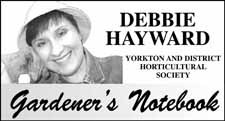I'd like to tell you about an interesting book that I borrowed from the Library: it's called "Maximizing Your Mini Farm: Self-Sufficiency on ¼ Acre" by Brett L. Markham. I know most of us don't plant up one-quarter acre for our gardens, but the author has some interesting ideas about growing our own food.
One of the opening comments he makes is that by growing our own fruits and/or vegetables, we take control. We know where the food comes from, and what kind of pesticides or insecticides have or haven't been put on it. By growing our own vegetables, we are able to eat things at the peak of their freshness. Mr. Markham's theory is that by growing our own food, we can relieve some economic stress because we can grow some of what we eat, giving us self-sufficiency. A couple months ago, when Glen Tymiak and I visited with the young gardeners at St. Paul's School, Glen explained to the children that every day they could go out to their gardens and see what was ready, and do their "shopping" there for the day's meal. I thought that was a wonderful way to explain the self-sufficiency of growing your own food. The author stresses this in his book as well: that the home can become a place of "production" rather than just "consumption".
The author of this book also makes a point that I believe right from my heart: that gardening "allows for more time, and better quality time, to be spent with kith and kin". He says "the time family spends together actively blanching broccoli is time that can be spent interactively, rather than merely being in proximity with each other while watching television". You know how many times I have mentioned the happy family times I enjoyed with my parents in our garden and yard - truly priceless memories I will always treasure. If we can give that to our families, what a gift.
So let me tell you about some of the gardening hints that I learned from this book. Let's start with corn. Mr. Markham tells us that sweet corn falls into three types: normal sugary (Su), Sugary Enhanced (Se) and Supersweet (Sh2). He says that Su and Se types are best for the home gardener because they are more tolerant of things like planting depth and soil temperature variations in our gardens. He tells us that corn is a "seriously hungry" plant, and needs a lot of light, water and food. He suggests that we add a lot of compost or manure to the area, as well as alfalfa meal and blood meal, which will give fast and slow-release nitrogen to the bed. Plant corn seeds one week after the last frost, one inch deep and twelve inches apart. Or, to get a bit of a head start, he suggests planting corn indoors and then transplanting to the garden.
And if you want to try planting beans with the corn, wait until the corn has been up for at least a week before you plant the beans, so that the beans, which are quick sprouters, will not shade the corn. Corn is wind-pollinated, but just to help it along once the tops have grown, Mr. Markham suggests that we give our corn plant a gentle shake once in a while to distribute pollen. We should start checking our corn about three weeks after the silks appear; when the silk turns dry and brown, and if the ears feel firm and the juice is milky if you burst one of the kernels, it's time to get out the butter and harvest the corn! Yummy!
The next meeting of the Yorkton and District Horticultural Society will be on Thursday, April 24. Please note the new date! Our guest will be Karen Leis speaking about vermiculture and composting with worms. Have a good week!




